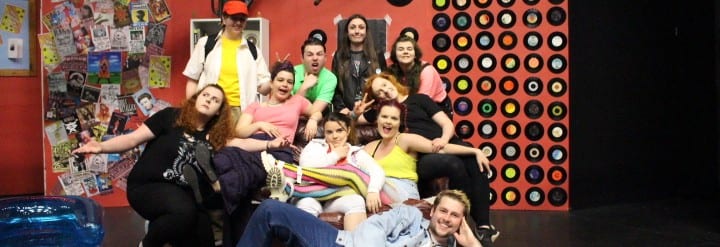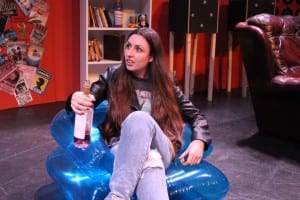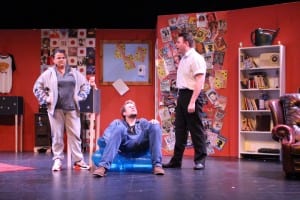“Story is a sequence of a certain kind of events, occurring in a special relationship with each other. Some plays have no story or only a vestige of one” (Sam Smiley, 2005, 101)
The world of Record ’97 has at times been described by members of our company and our tutor Mark as a Beckettian farce. Waiting for Godot was an early inspiration that was maintained throughout due to its cyclical and non-progressive plot, and it helped us to develop our own story and an approach to telling it until we were able to do our own thing and create our own style of storytelling. To say that nothing happens would be inaccurate, as the focus of the story is on the ensemble and their response to the situation rather than the situation itself. The situation is more of a catalyst for the characters to realise what they might lose, and it brings them closer together by the end.
“The subject of a play amounts to the total activity of the characters as they respond to their surroundings. A subject also involves social, professional, and personal relationships” (Sam Smiley, 2005, 11)
The themes of home and prison that added to the nature of our play and its structure are woven throughout and added to characters actions and choices. My previous concerns regarding exposition prevented us from exploring this theme in more depth, but where it was featured it did add depth to the characters and their relationships with each other and the store, which in its own way was a character both visually and symbolically. In no character was this more prominent than Daisy, who held the strongest attachment to the store and it came to represent a prison for the memories it held, and a home for what she wanted it to be and was making it with her maternal responsibility over the other characters (Figure 1).
“TIFF. Why did you stay here?
DAISY. Because this place is the only thing I’ve got left of him. Memories. Same with these (Indicates vinyls). And because I had nowhere else to go. (Beat) Like you don’t have anywhere else.”
(Jack Briggs, 2017)
“Characters don’t exist in a vacuum. They’re a product of their environment” (Linda Seger, 1990, 5)
Beyond Beckett, the play also takes inspiration from the average episode of most sitcoms; in the sense that the events of the plot are self-contained and by the end the equilibrium is restored, even if something has changed for the characters. Some examples would be Sebastian entering another unrequited love triangle, Alex still serving as a terrible musician looked down on by everybody, and Daisy still stuck with her adopted family of misfits in a place she had only just come to terms with losing. Even characters that have made a progression in their lives enter a new stage that lends a different opportunity for comedy. David and Sherice would be the best example of this; starting as a stereotypical will-they-won’t-they relationship that generated humour through their awkward attraction and attempts to do something about it (added to by Sebastian’s disruption), to comedy that flows from their awkwardness as a couple and the effects of their relationship on those around them and themselves (Figure 2).
Even the ending draws parallels to a typical sitcom episode, as the story isn’t resolved until the very last minute, and suddenly the events of the play are almost irrelevant to most of the characters (Figure 3). This circles back to the concept of nothing ever changing that we as a company had at the beginning of the process, and I believe we were successful in this through the characters behaviours and responses to the world around them.
Works Cited:
Briggs, J. (2017) Record ’97. Lincoln.
Noble, R. (2017) Record ’97. [image] Lincoln Performing Arts Centre: Kick a Pigeon Theatre.
Seger, L. (1990) Creating Unforgettable Characters. New York: Henry Holt and Company, LLC.
Smiley, S., Bert, N.A. (2005) Playwriting: The Structure of Action. Expanded Edition. New Haven, CT: Yale University Press.



